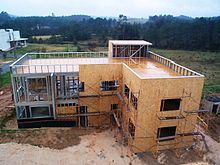Oriented strand board (OSB), also known as sterling board, sterling OSB, aspenite, and smartply in British English, is an engineered wood particle board formed by adding adhesives and then compressing layers of woodstrands (flakes) in specific orientations. It was invented by Armin Elmendorf, California US in 1963 OSB Pate OSB may have a rough and variegated surface with the individual strips of around 2.5 × 15 cm (1" × 6"), lying unevenly across each other and comes in a variety of types and thicknesses.

Uses
OSB is a material with high mechanical properties that make it particularly suitable for load-bearing applications in construction. The most common uses are as sheathing in walls, flooring, and roof decking. For exterior wall applications, panels are available with a radiant-barrier layer pre-laminated to one side; this eases installation and increases energy performance of the building envelope. OSB also sees some use in furniture-production.

Manufacturing
Materials other than wood have been used to produce products similar to oriented strand board. Oriented structural straw board is an engineered board that is made by splitting straw and formed by adding P-MDI adhesives and then hot compressing layers of straw in specific orientations. Strand board can also be made from bagasse.
Properties

OSB is easily identifiable by its characteristic wood strands
Uses
OSB is a material with high mechanical properties that make it particularly suitable for load-bearing applications in construction. The most common uses are as sheathing in walls, flooring, and roof decking. For exterior wall applications, panels are available with a radiant-barrier layer pre-laminated to one side; this eases installation and increases energy performance of the building envelope. OSB also sees some use in furniture-production.

OSB is used in housing construction.
Manufacturing
Oriented strand board is manufactured in wide mats from cross-oriented layers of thin, rectangular wooden strips compressed and bonded together with wax and synthetic resin adhesives (95% wood, 5% wax and resin). The resin types typically used include Phenol formaldehyde (PF), melamine fortified Urea Formaldehyde (MUF) or isocyanate (PMDI), all of which are moisture resistant binders. In Europe, it is common to use a combination of binders, typically PMDI would be used in the core and MUF in the face layers and this has the advantage of reducing press cycles whilst imparting a bright appearance to the surface of the panel.
OSB in production before gluing in a thermal press
The layers are created by shredding the wood into strips, which are sifted and then oriented on a belt or wire cauls. The mat is made in a forming line. Wood strips on the external layers are aligned to the panel's strength axis, while internal layers are perpendicular. The number of layers placed is determined partly by the thickness of the panel but is limited by the equipment installed at the manufacturing site. Individual layers can also vary in thickness to give different finished panel thicknesses (typically, a 15 cm layer will produce a 15 mm panel thickness). The mat is placed in a thermal press to compress the flakes and bond them by heat activation and curing of the resin that has been coated on the flakes. Individual panels are then cut from the mats into finished sizes. Most of the world's OSB is made in the United States and Canada in large production facilities. The largest production facilities can make over 1,000,000 square feet (93,000 square metres) of OSB per day.
Related ProductsMaterials other than wood have been used to produce products similar to oriented strand board. Oriented structural straw board is an engineered board that is made by splitting straw and formed by adding P-MDI adhesives and then hot compressing layers of straw in specific orientations. Strand board can also be made from bagasse.
Properties
Adjustments to the manufacturing process can impart differences in thickness, panel size, strength, and rigidity. OSB panels have no internal gaps or voids, and are water-resistant, although they do require additional membranes to achieve impermeability to water and are not recommended for exterior use. The finished product has properties similar to plywood, but is uniform and cheaper. When tested to failure, OSB has a greater load-bearing capacity than milled wood panels. It has replaced plywood in many environments, especially the North American structural panel market.
OSB, closeup of corner
While OSB does not have a continuous grain like a natural wood, it does have an axis along which its strength is greatest. This can be seen by observing the alignment of the surface wood chips.
All wood-based structural use panels can be cut and installed with the same ease and types of equipment used with solid wood.
Safety and Health
The resins used to create OSB have raised questions regarding the potential for OSB to emit volatile organic compounds (VOCs) such as formaldehyde. Urea-formaldehyde is more toxic and should be avoided in anything you put in your home. Phenol-formaldehyde products are considered to be relatively hazard-free. Some newer types of OSB, so-called "New-generation" OSB panels, use isocyanate resins that do not contain formaldehyde and are considered non-volatile when cured. Industry trade groups assert that formaldehyde emissions from North American OSB are "negligible or nonexistent".
Some manufacturers treat the wood chips with various borate compounds which are toxic to termites, wood boring beetles, molds, and fungi, but not mammals in applied doses.
Types
Four grades of OSB are defined in EN 300 in terms of their mechanical performance and relative resistance to moisture:
- OSB/1 – General purpose boards and boards for interior fitments (including furniture) for use in dry conditions
- OSB/2 – Load-bearing boards for use in dry conditions
- OSB/3 – Load-bearing boards for use in humid conditions
- OSB/4 – Heavy-duty load-bearing boards for use in humid conditions
- Wikipedia







No comments:
Post a Comment